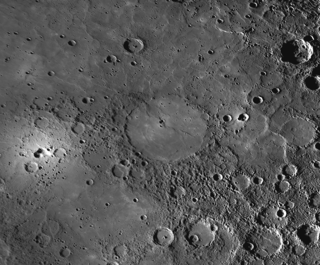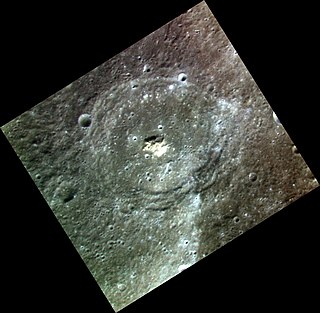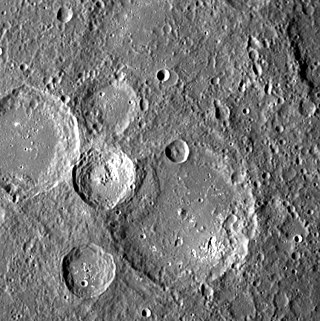
Matisse is an impact crater on the southern hemisphere of Mercury. Matisse takes its name from the French artist Henri Matisse, and it was named by the IAU in 1976.

Verdi is an impact crater on the planet Mercury. It was named after Italian Romantic composer Giuseppe Verdi (1813–1901) in 1979, as recognized by the International Astronomical Union. The crater's extensive ejecta blanket and secondary crater field are superposed on plains materials and older craters.

Praxiteles is a crater on Mercury. It is one of 110 peak ring basins on Mercury.

Abedin is a crater on Mercury. It was named after the Bangladeshi artist Zainul Abedin by the IAU in 2009.

Copland is an impact crater on Mercury. Its floor is flooded with volcanic smooth plains material, which could be related to the activity that formed the nearby bright vent known as Nathair Facula.

Matabei is an impact crater on Mercury. It has a set of dark rays. Dark rays are rare on Mercury, but other occurrences have been identified, such as at Mozart crater. Mozart crater is interpreted to have excavated dark material from depth during the impact event, creating dark streamers. The dark rays from Matabei may have a similar origin.

Gluck is a crater on Mercury. It has a diameter of 100 kilometers. Its name was adopted by the International Astronomical Union (IAU) in 1979. Gluck is named for the Austrian composer Christoph Willibald Gluck, who lived from 1714 to 1787.

Gogol is a crater on Mercury. Its name was adopted by the International Astronomical Union (IAU) in 1985. Gogol is named for the Russian playwright Nikolai Gogol, who lived from 1809 to 1852.

Grieg is a crater on Mercury. It has a diameter of 59 kilometers. Its name was adopted by the International Astronomical Union (IAU) in 1985. Grieg is named after the Norwegian composer Edvard Grieg, who lived from 1843 to 1907.

Heine is a crater on Mercury. It has a diameter of 73 kilometers. Its name was adopted by the International Astronomical Union (IAU) in 1979. Heine is named for the German poet Heinrich Heine, who lived from 1797 to 1856.

Holbein is a crater on Mercury. Its name was adopted by the International Astronomical Union (IAU) in 1979. Holbein is named for the Germain painters Hans Holbein the Elder, who lived from 1465 to 1524, and Hans Holbein the Younger, who lived from 1497 to 1543.

Jókai is a crater on Mercury. Its name was adopted by the International Astronomical Union (IAU) in 1979. Jokai is named for the Hungarian novelist Mór Jókai, who lived from 1825 to 1904.

Leopardi is a crater on Mercury. Its name was adopted by the International Astronomical Union in 1976. Leopardi is named for the Italian writer Giacomo Leopardi, who lived from 1798 to 1837.

Mansart is a crater on Mercury. Its name was adopted by the International Astronomical Union (IAU) in 1979. Mansart is named for the French architect Jules Hardouin-Mansart, who lived from 1646 to 1708.

Mark Twain is a crater on Mercury. Its name was adopted by the International Astronomical Union (IAU) in 1976. Mark Twain is named for the American author Mark Twain, who lived from 1835 to 1910.

Mistral is a crater on Mercury. Its name was adopted by the International Astronomical Union (IAU) in 1976. Mistral is named for the Chilean poet Gabriela Mistral, who lived from 1889 to 1957.

Monet is a crater on Mercury. Its name was adopted by the International Astronomical Union (IAU) in 1979. Monet is named for the French artist Claude Monet, who lived from 1840 to 1926.

Neumann is a crater on Mercury. It has a diameter of 120 kilometers. Its name was adopted by the International Astronomical Union (IAU) in 1976. Neumann is named for the German architect Johann Balthasar Neumann, who lived from 1687 to 1753.

Ovid is a crater on Mercury. Its name was adopted by the International Astronomical Union (IAU) in 1976. Ovid is named for the Roman poet Ovid, who lived from 43 BCE to 17 CE.



















